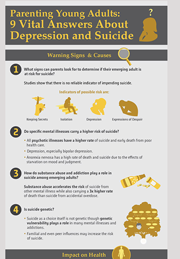Family Support during Deployment Reduces Suicidal Thoughts in Veterans
Boston, MA; March 16, 2015—Family support during deployment is an important protective factor against post-deployment suicidal ideation according to a new study in the journal Anxiety, Stress and Coping.
(Full story . . . )
World Suicide Prevention Day: Young People Who Have Attempted Suicide Disadvantaged on the Job Market
September 8, 2014—People who have attempted suicide when young are less likely to have a successful professional career later in life. This was discovered in a joint study by the Swedish Karolinska Institutet and MedUni Vienna. The prospect of long-term unemployment later in life threatens many people who have attempted suicide once or more. However, they make up an even larger proportion of the statistics for long-term sick leave and disability pensions.
(Full story . . . )
A Blood Test for Suicide?
Alterations to a single gene could predict risk of suicide attempt
July 30, 2014—Johns Hopkins researchers say they have discovered a chemical alteration in a single human gene linked to stress reactions that, if confirmed in larger studies, could give doctors a simple blood test to reliably predict a person's risk of attempting suicide.
(Full story . . . )
Study Finds That Suicides Are Far More Likely to Occur after Midnight
Darien, IL; June 2, 2014—A new study provides novel evidence suggesting that suicides are far more likely to occur between midnight and 4 a.m. than during the daytime or evening.
(Full story . . . )
Study Reveals 10 Percent of 16-Year-Olds Surveyed Have Considered Self-Harm
May 16, 2014—One in ten 16-year-olds surveyed in a new study by Queen's University and the University of Ulster have considered self-harm or taking an overdose.
(Full story . . . )
Catastrophic Thoughts about the Future Linked to Suicidal Patients
April 28, 2014—Suicide has been on the increase recently in the United States, currently accounting for almost 40,000 deaths a year. A new study indicates that one important strategy for reducing suicide attempts would be to focus on correcting the distorted, catastrophic thoughts about the future that are held by many who try to kill themselves. Such thoughts are unique and characteristic to those who attempt suicide, says Shari Jager-Hyman of the University of Pennsylvania Perelman School of Medicine in the US.
(Full story . . . )
Study: Online Self-Injury Information Often Inaccurate
March 31, 2014—People seeking help or information online about cutting and other forms of self-injury are likely finding falsehoods and myths, according to new research from the University of Guelph.
(Full story . . . )
Suicide Risk Doesn't Differ in Children Taking 2 Types of Commonly Prescribed Antidepressants
January 6, 2014—A Vanderbilt University Medical Center study released today shows there is no evidence that the risk of suicide differs with two commonly prescribed antidepressants prescribed to children and adolescents.
(Full story . . . )
Up to 1 in 4 Female Prisoners in England and Wales Self-Harm
December 15, 2013—Led by Dr. Seena Fazel and Professor Keith Hawton from the University of Oxford in the UK, the study examined the prevalence of self-harm in all prisoners in England and Wales between 2004 and 2009—a total of 139,195 incidents of self-harm, involving 26,510 inmates. Risk factors for self-harm were assessed and compared with those of the general prison population, and associations with suicide examined.
(Full story . . . )
How the Internet Affects Young People at Risk of Self-Harm or Suicide
Researchers find both positive and negative effects of the Internet, depending on vulnerability
October 30, 2013—Oxford researchers have found internet forums provide a support network for socially isolated young people. However, they also conclude that the internet is linked to an increased risk of suicide and self-harm among vulnerable adolescents. Following what is thought to be the biggest review of existing studies into internet use and young people, the researchers suggest that in future, clinical assessments of such young people should include questions about the online content they have viewed.
(Full story . . . )
Suicidal Talk on Twitter Mirrors Suicide Rates
Ocotber 9, 2013—Heart-breaking accounts of cyber bullying and suicide seem all too common, but a new study offers hope that social media can become an early warning system to help prevent such tragedies.
(Full story . . . )
Myth-Busting on World Suicide Prevention Day
Mayo Clinic, American Foundation for Suicide Prevention Debunk Common Suicide Myths
ROCHESTER, MN; September 10, 2013—Talking to someone about suicide will increase the chances that they will act on it—true or false? False. The truth: When someone is in crisis or depressed, asking if he or she is thinking about suicide can help. Giving a person an opportunity to open up and share their troubles can help alleviate their pain and open a path to solutions. This is just one of many suicide prevention myths to debunk as we approach World Suicide Prevention Day on Sept. 10.
(Full story . . . )
Researchers Identify Biomarkers for Possible Blood Test to Predict Suicide Risk
INDIANAPOLIS; August 20, 2013—Indiana University School of Medicine researchers have found a series of RNA biomarkers in blood that may help identify who is at risk for committing suicide.
(Full story . . . )
Teen Eating Disorders Increase Suicide Risk
Johns Hopkins researchers find connection between body dissatisfaction, depressive/anxious symptoms, and binge eating.
NEW YORK; July 22, 2013—Is binge eating a tell-tale sign of suicidal thoughts?
According to a new study of African American girls, by Dr. Rashelle Musci and colleagues from the Bloomberg School of Public Health at Johns Hopkins University, those who experience depressive and anxious symptoms are often dissatisfied with their bodies and more likely to display binge eating behaviors. These behaviors put them at higher risk for turning their emotions inward, in other words, displaying internalizing symptoms such as suicide. The study is published online in Springer's journal, Prevention Science.
With the focus on appearance in Western culture, it is not uncommon for many girls and women to have eating behavior problems. The most frequently occurring problem eating behaviors are binge eating, or eating large amounts of food in a short period of time and feeling out of control while eating. This behavior leads to shame, embarrassment, distress and an attempt to conceal it.
(Full story . . . )
Consider a Text for Teen Suicide Prevention and Intervention, Research Suggests
COLUMBUS, OH; June 24, 2013—Teens and young adults are making use of social networking sites and mobile technology to express suicidal thoughts and intentions as well as to reach out for help, two studies suggest.
(Full story . . . )
Study Examines Suicide Risk and Protective Factors for Youth Involved in Bullying
MINNEAPOLIS/ST. PAUL; June 19, 2013—New research out of the University of Minnesota identifies significant risk factors for suicidal behavior in youth being bullied, but also identifies protective factors for the same group of children.
(Full story . . . )
First Major Study of Suicide Motivations to Advance Prevention
June 13, 2013—A University of British Columbia study sheds important new light on why people attempt suicide and provides the first scientifically tested measure for evaluating the motivations for suicide. The study, based on 120 participants who recently attempted suicide, suggests many motivations believed to play important roles in suicide are actually relatively uncommon.
(Full story . . . )
Suicide Risk Factors Mapped
June 10, 2013—A landmark study of the Swedish population has given a clearer picture of important risk factors for suicide. The study, a collaboration between Lund University in Sweden and Stanford University, showed that the rate of suicide among men is almost three times that of women. Being young, single and having a low level of education were stronger risk factors for suicide among men, while mental illness was a stronger risk factor among women. Unemployment was the strongest social risk factor among women, whereas being single was the strongest among men.
(Full story . . . )
Childhood Bullying Increases the Risk of Self-Harm During Adolescence
WARWICK, U.K; May 28, 2013—A new study has proven that being bullied during childhood directly increases the likelihood of self- harm in late adolescence.
(Full story . . . )
Teens Exposed to Peer Death by Suicide Much More Likely to Consider Suicide
Study supports idea of 'suicide contagion,' especially in 12 and 13 year olds
May 21, 2013—Youth who had a schoolmate die by suicide are significantly more likely to consider or attempt suicide, according to a study in published in CMAJ (Canadian Medical Association Journal). This effect can last 2 years or more, which has implications for strategies following schoolmate suicides.
(Full story . . . )
Myths and Facts about Adolescent Suicide
October 24, 2012—According to Maurizio Pompili, Professor of Suicidology at Sapienza University's Medical School in Rome, Italy, the first step in suicide prevention is trustful communication between adults and adolescents. Achieving this requires correcting some of the enduring myths people hold about adolescent suicide.
(Full story . . . )
What Killed Amanda Todd? A Look at Cyberbullying and Teen Suicide
The tragic death by suicide of fifteen-year-old Canadian Amanda Todd on October 10, 2012, brought several important issues into the media spotlight. Chief among them were cyberbullying, mental health issues and Internet safety. It also sparked discussions about vigilante vengeance as Anonymous “hacktivists” trained their sights on Amanda’s online tormenter and blackmailer, whose cyber-weapon was a risqué Webcam image of the young girl taken when she was only twelve.
(Full story . . . )
Cyberbullying: 1 in 2 Victims Suffer from the Distribution of Embarrassing Photos and Videos
July 25, 2012—Researchers at Bielefeld University have discovered that young people who fall victim to cyberbullying or cyber harassment suffer most when fellow pupils make them objects of ridicule by distributing photographic material. According to an online survey published this month, about half of the victims feel very stressed or severely stressed by this type of behaviour.
(Full story . . . )
Cyberbullying and Bullying Are Not the Same, Says Research
April 13, 2012—University of British Columbia research comparing traditional bullying with cyberbullying finds that the dynamics of online bullying are different, suggesting that anti-bullying programs need specific interventions to target online aggression.
(Full story . . . )


